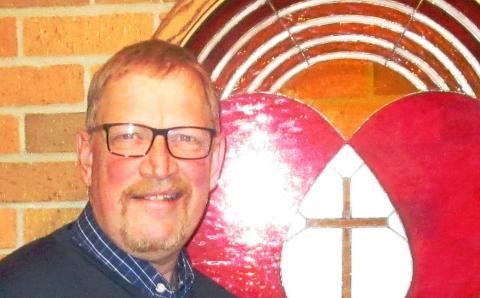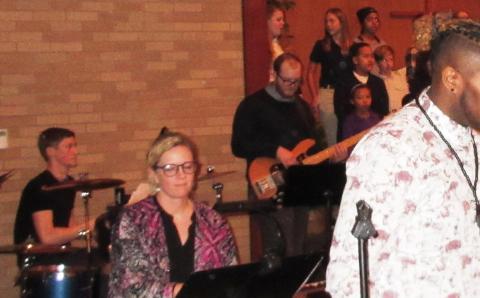A full-blown panic attack hit Rev. Rick Nanninga as he was preaching at Trinity Christian Reformed Church in Edmonton, Alta., on New Year’s Day in 1987.
Waves of vertigo washed over him, sweat broke out, and he felt like he was going to throw up. Somehow Nanninga managed to get through the sermon. He finished the service and was even able to shake everyone’s hand and wish them a happy New Year.
After that, he said, he raced to his office, where he dropped to the floor and, shaking with fear, curled up in a ball. His wife, Elizabeth, found him a few minutes later and took him home.
“After that, I was totally locked up in my house for three weeks. The panic was so big that I thought I was going to die,” said Nanninga, who is now pastor of Barrhaven Fellowship in Ottawa, Ont.
Looking back, Nanninga attributes the stress of being a youth minister and then an interim pastor as triggering the attack on the pulpit.
At home, Nanninga didn’t answer the phone, kept the curtains closed, and ran into his bedroom when church members came over with flowers.
“I couldn’t handle people. I couldn’t handle noise. I thought my role in ministry was done,” said Nanninga. “I felt overwhelmed and burned out.”
Late last year, Nanninga told his story at a meeting of Classis Eastern Canada as part of a presentation for the new Guide for a Clergy Leave of Absence for Mental Health Reasons, a toolkit produced by the joint Disability Concerns office of the CRC and the Reformed Church in America.
“I believe this guide is a really big deal, and we did a trial run to see how it was accepted,” he said. “The reaction in the room to my story was emotional. People could relate to the stress of being a pastor, to pushing too hard, and what that can do.”
Nanninga was part of the Mental Health Task Force established by Disability Concerns. The task force assists congregations in ministry with people with mental health issues; the Guide for Clergy Leave was their latest project.
To create the guide, the task force put together a team that included pastors, chaplains, therapists, members of CRC Pastor Church Resources, mental health service providers, and individuals who have experienced mental illness themselves.
Their goal was to develop a free resource that would give guidance to churches and pastors facing difficult situations such as clergy burnout and mental health issues. They provided recommendations on how to coordinate between the church, the pastor, and the pastor’s health care providers, and how to make arrangements for a leave..
In addition to the guide, the team also produced PowerPoint presentations, case studies, and a leader’s guide so that someone with a willing heart could facilitate a group conversation at a classis or congregational meeting about clergy mental health.
“This is not a policy. Churches can do what they want; but we thought these resources would be helpful for churches and pastors who face a difficult situation,” said Mark Stephenson, director of CRC Disability Concerns.
Research shows that nearly one in four pastors acknowledges having struggled with mental illness, and a significant number also experience burnout, an inability to keep going in their job, for a variety of reasons. Often pastors endure these struggles on their own, fearing the stigma attached to having personal problems and fear of what the church might think.
Nanninga played an important role in the development of the new resources, especially because of the challenges he has faced and been able to work through, said Stephenson.
“We are very thankful for Rick being part of the team,” he said. “We appreciated his transparency and his wisdom that comes from a number of years of experience in parish ministry.”
There was no formal leave of absence policy in place at the time Nanninga had the panic attack and then locked himself away at home, but the church gave him time to sort things out.
Early on, he visited a psychiatrist, who listened to his story and diagnosed him with agoraphobia, which is “a fear of being in a situation where a person can’t escape or find help if they experience a panic attack or other feelings of anxiety,” according to the Canadian Mental Health Association.
“This is a fear of crowds. In the spectrum of anxiety disorders, this is a bad one,” said Nanninga. “Before that incident on the pulpit, I had been feeling increasingly worse. I had gone to the doctor, but he never found anything.”
Thinking back, he realized that he had battled anxiety for much of his life, in school and seminary, but it really took hold when he answered the call to his first church in Edmonton.
The psychiatrist recommended facing his fears by visiting the places that scared him the most. The doctor encouraged him to stay there as the panic rose and remain until it eased.
Among the first places he went was a large mall with his daughter. “I believed I would have to stay because I was taking care of her,” he said.
As they walked through the mall, the anxiety, and with it a flood of adrenaline, kicked in. It was terrifying, but he stuck with it, praying and trying to float above the panic. Eventually the fear subsided.
He visited other places as well—a barber shop, a hockey game—and took walks around his neighborhood. Within several weeks, he was standing behind the pulpit as a visiting pastor in a small church in Edmonton.
This was the real test, he said. Being in church was at the top of his list of places causing fear.
As he gulped back the anxiety, he glanced in the back of the church and saw several women who had come to the service to support him and to hear him preach.
“These women were struggling with the same thing that I was. They were there because they were nervous for me. It was great; it helped,” said Nanninga.
He made it through that sermon. “I was reconnecting with the world and reclaiming these places in my life,” he said.
The road back wasn’t straight or easy, but he kept at it, finding help in surprising places as he took other positions in ministry. He recalls being called one night, when he was serving Clarkson CRC in Mississauga, Ont., to meet a man who was feeling suicidal.
They met in the laundry room of the highrise apartment where the man lived. The man told him he had become a Christian, but his panic was getting bad, keeping him from his factory job and making him feel anxious when riding the bus or going anywhere. He was at the end of his rope.
“It was an amazing thing,” said Nanninga. “I told the man, ‘I am you and you are me, and God is using this to help us both and let us know that God is in control and will see us through.’”
Over time, Nanninga went through counseling and had to deal with such things as the anxiety that rose when having to fly in planes for church-related interviews and meetings. He especially recalls the time he and his wife drove a busy freeway into Toronto to attend a March for Jesus. The anxiety caused him to turn back several times.
When they got to the church where the march began, he was unable to go through the doors. His wife went in, and he walked around the city most of the day, calling out to God for help with the pain and panic he still felt.
He returned to the church in the early evening for the concluding service and sat in the balcony as a minister spoke about how pastors were sometimes wounded by their churches and how you could see demonic forces at work in this.
When it came time to pray, Nanninga began to cry and fell on his knees. As people gathered around to pray for him, he felt as though “something very dark left me,” he said.
After that, his preaching improved, his anxiety calmed, and he took more pleasure in his pastoral work, reaching out to church members as well as others who also struggled in different ways.
One of those people was Rev. John Van Sloten, pastor of New Hope Hillside Church in Calgary, Alta. Working as a real estate developer at the time, Van Sloten was feeling lost. He recalls how meeting Nanninga changed his life and inspired him to go into ministry. That was 25 years ago.
“Rick was very much like God to me in his ceaseless capacity to listen,” said Van Sloten. “He always made time to talk. He had a huge discipling vision to come alongside us in an incarnational way. . . . It is uncanny how many people such as myself are today in ministry because of him.”
Nanninga said that he knows how fortunate he is that God stayed close to him in his times of need, and that not every pastor who struggles with mental illness is able to find help and become successful in ministry.
“I am sensitive to other people’s challenges and of the need for healing in their lives,” said Nanninga. “I see my time in the wilderness as a time where God remade me and deliverance came. But I know that doesn’t happen for everyone. My hope has been that I can be there for others when they need it.”
For those who can’t have personal contact with someone like Nanninga, the Guide for Clergy Leave is another resource.
"At the CRC synod in 2014, a pastor asked me to have the Disability Concerns office address the issue of clergy mental health because he had faced the issue himself and it had not gone well," Stephenson said. "He certainly is not the only one. I'm pleased with the way that we have been able to respond to this pastor's request and pray that the guide and the supporting materials can help pastors and congregations not just survive a mental health crisis, but make the journey in a healthy way with a deep understanding of God's grace and an increasing ministry to everyone affected by mental illness."
The guide and supporting resouces can be found at www.crcna.org/clergyleaveguide.
About the Author
Chris Meehan is a freelance writer and commissioned pastor at Coit Community Church in Grand Rapids, Mich.









